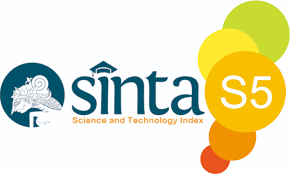Implementasi Machine Learning Untuk Prediksi Penjualan Oli Shell Pada CV. Harapan Karya Mandiri Bengkulu
Abstract
Prediction is an activity of guessing or estimating something that will happen in the future by utilizing historical data through a scientific method. CV. Harapan Karya Mandiri in predicting oil sales is still in a conventional way. The weaknesses of conventional systems are in addition to human error in doing calculations and writing and can also be lost when doing recapitulation. For this reason, a machine learning technique is needed that is able to predict sales. One of the algorithms included in Machine Learning is K-Nearest Neighbor. The system implementation uses the PHP programming language with the MySql database and the method used in this research is the Waterfall method. The waterfall method is able to analyze the needs used to find out from the weaknesses of the old system, then make a design of the design and continue with the design of the new system. The conclusion from the results of this study explains that the sales prediction process with the K-Nearest Neighbor method first goes through a training process. The prediction results are also strongly influenced by the amount of data being trained and the value of "k" in this method.
Downloads
References
DAFTAR PUSTAKA
Anisa, C., & Andri. (2021). Penerapan Algoritma K-Nearest Neighbor Untuk Prediksi Penjualan Obat Pada Apotek Kimiafarma Atmo Palembang. Bina Darma Conference on Computer Science, 199-208.
Chen, Z., Zhou, L. J., Li, X. Da, Zhang, J. N., & Huo, W. J. (2020). The Lao text classification method based on KNN. Procedia Computer Science,Vol.166, hal. 523–528. Elsevier B.V. https://doi.org/10.1016/j.procs.2020.02.053
Deng, S., Wang, L., Guan, S., Li, M., & Wang, L.(2023). Non-parametric Nearest Neighbor Classification Based on Global Variance Difference. nternational Journal of Computational Intelligence Systems, 16(1). https://doi.org/10.1007/s44196-023-00200-1
Dinata, R. K., Akbar, H., & Hasdyna, N. (2020).Algoritma K-Nearest Neighbor dengan Euclidean Distance dan Manhattan Distance untuk Klasifikasi Transportasi Bus. ILKOM Jurnal Ilmiah, 12(2), 104–111. https://doi.org/10.33096/ilkom.v12i2.539.104-111
Dwilaga, A. T. (2022). Implementasi Model Artificial Intelligence Dalam Warehouse : Systematic Literature Review. JUSTI (Jurnal Sistem dan Teknik Industri), 253-261.
Handayani, V. R., Wijianto, R., & Anggoro, A. (2020). Sistem Informasi Pendaftaran Seleksi Kerja Berbasis Web Pada BKK (Bursa Kerja Khusus) Tunas Insan Karya SMK Negeri 2 Banyumas. Jurnal Evolusi, 76-84.
Kutyauripo, I., Rushambwa, M., & Chiwazi, L. (2023). Artificial intelligence applications in the agrifood sectors. Journal of Agriculture and Food Research, 1-8.
Lubis, M. Y. (2021). Implementasi Artificial Intelligence Pada System Manufaktur Terpadu. SEMNASTEK UISU, 1-7.
Ma, X., Han, Y., Qin, H., & Wang, P. (2023). KNN Data Filling Algorithm for Incomplete Interval-Valued Fuzzy Soft Sets. International Journal of Computational Intelligence Systems, 16(1). https://doi.org/10.1007/s44196-023-00190-0
Mikhael, Andreas, F., & Enri, U. (2022). Perbandingan Algoritma Linear Regression, Neural Network, Deep Learning, Dan K-Nearest Neighbor (K-NN) Untuk Prediksi Harga Bitcoin. JSI : Jurnal Sistem Informasi, 2450-2464.
Mubarak, A. (2019). Rancang Bangun Aplikasi Web Sekolah Menggunakan UML (Unified Modeling Language) Dan Bahasa Pemrograman PHP (PHP Hypertext Preprocessor) Berorientasi Objek. JIKO (Jurnal Informatika dan Komputer), 19-25.
Novendri, M. S., Saputra, A., & Firman , C. E. (2019). Aplikasi Inventaris Barang Pada MTS Nurul Islam Dumai Menggunakan PHP Dan Mysql. Lentera Dumai, 46-57.
Nurmalasari, Anna, & Arissusand, R. (2019). Rancang Bangun Sistem Informasi Akuntansi Laporan Laba Rugi Berbasis Web Pada PT. United Tractors Pontianak. Evolusi: Jurnal Sains dan Manajemen, 6-14.
Nursyanti, R., Alamsyah, R. R., & Perdana, S. (2019). Perancangan Aplikasi Berbasis Web Untuk Membantu Pengujian Kualitas Kain Tekstil Otomotif (Studi Kasus Pada PT. Ateja Multi Industri). Explore – Jurnal Sistem Informasi dan Telematika, 153-159.
Rizki, M. A., & OP, A. (2021). Rancang Bangun Aplikasi E-Cuti Pegawai Berbasis Website (Studi Kasus : Pengadilan Tata Usaha Negara). Jurnal Teknologi dan Sistem Informasi (JTSI), 1-13.
Roihan, A., Sunarya, P. A., & Rafika, A. S. (2020). Pemanfaatan Machine Learning dalam Berbagai Bidang : Review paper. IJCIT (Indonesian Journal on Computer and Information Technology), 75-82.
Saragih, J. R., Saragih, M. S., & Wanto, A. (2020). Analisis Algoritma Backpropagation Dalam Prediksi Nilai Ekspor (JUTA USD) . Jurnal Pendidikan Teknologi dan Kejuruan, 254-264.
Silalahi, A. P., Simanullang, H. G., & Hutapea, M. I. (2023). Supervised Learning Metode K-Nearest Neighbor Untuk Prediksi Diabetes Pada Wanita. METHOMIKA: Jurnal Manajemen Informatika & Komputerisasi Akuntansi, 138-149.
Ummah, H., Sodikin, I., & Susetyo, J. (2019). Perancangan Sistem Informasi Rental & Inventaris Alat Multimedia Berbasis Web Menggunakan Metode Customer Relationship ManagemenT. JURNAL REKAVASI (Rekayasa dan Inovasi Teknik Industri), 15-24.
Wahyuni, R., & Irawan, Y. (2020). Aplikasi E-BOOK Untuk Aturan Kerja Berbasis Web Di Pengadilan Negeri Muara Bulian Kelas II Jambi . Jurnal Ilmu Komputer, 20-26.
Yulianeu, A., & Oktamala, R. (2022). Sistem Informasi Geografis Trayek Angkutan Umum Di Kota Tasikmalaya Berbasis Web. JUTEKIN (JURNAL TEKNIK INFORMATIKA), 125-134
Copyright (c) 2024 Dellya Septari; Indra Kanedi; Juju Jumadi

This work is licensed under a Creative Commons Attribution-ShareAlike 4.0 International License.
An author who publishes in Jurnal Media Infotama agrees to the following terms:The author holds the copyright and grants the journal the right of first publication of the work simultaneously licensed under the Creative Commons Attribution-Share Alike 4.0 License which allows others to share the work with acknowledgment of the work's authorship and initial publication in this journal.Submission of a manuscript implies that the submitted work has not been previously published (except as part of a thesis or report, or abstract); that it is not being considered for publication elsewhere; that its publication has been approved by all co-authors. If and when a manuscript is accepted for publication, the author retains the copyright and retains the publishing rights without limitation.
For new inventions, authors are advised to administer the patent before publication. The license type is CC-BY-SA 4.0.
MEDIA INFORMATION REVIEW: Journal of the Faculty of Computer Science is licensed under a Creative Commons Attribution-ShareAlike 4.0 International License.You are free to:Share
— copy and redistribute material in any medium or formatAdapt
— remix, modify and develop materialfor any purpose, even commercial.
The licensor cannot revoke this freedom as long as you follow the license terms












.png)


